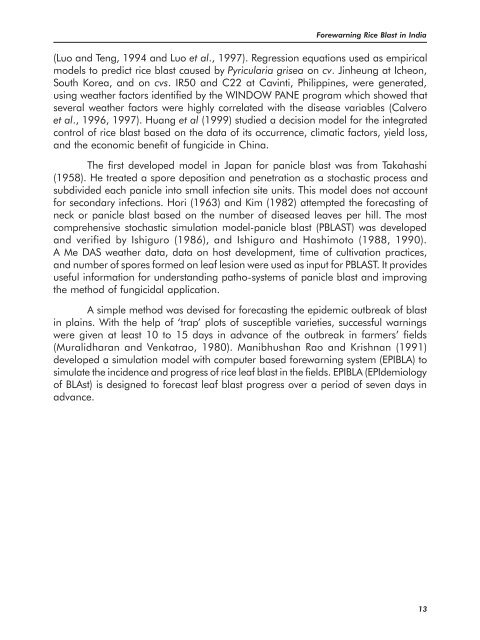Forewarning Rice Blast in India
Forewarning Rice Blast in India
Forewarning Rice Blast in India
Create successful ePaper yourself
Turn your PDF publications into a flip-book with our unique Google optimized e-Paper software.
<strong>Forewarn<strong>in</strong>g</strong> <strong>Rice</strong> <strong>Blast</strong> <strong>in</strong> <strong>India</strong><br />
(Luo and Teng, 1994 and Luo et al., 1997). Regression equations used as empirical<br />
models to predict rice blast caused by Pyricularia grisea on cv. J<strong>in</strong>heung at Icheon,<br />
South Korea, and on cvs. IR50 and C22 at Cav<strong>in</strong>ti, Philipp<strong>in</strong>es, were generated,<br />
us<strong>in</strong>g weather factors identified by the WINDOW PANE program which showed that<br />
several weather factors were highly correlated with the disease variables (Calvero<br />
et al., 1996, 1997). Huang et al (1999) studied a decision model for the <strong>in</strong>tegrated<br />
control of rice blast based on the data of its occurrence, climatic factors, yield loss,<br />
and the economic benefit of fungicide <strong>in</strong> Ch<strong>in</strong>a.<br />
The first developed model <strong>in</strong> Japan for panicle blast was from Takahashi<br />
(1958). He treated a spore deposition and penetration as a stochastic process and<br />
subdivided each panicle <strong>in</strong>to small <strong>in</strong>fection site units. This model does not account<br />
for secondary <strong>in</strong>fections. Hori (1963) and Kim (1982) attempted the forecast<strong>in</strong>g of<br />
neck or panicle blast based on the number of diseased leaves per hill. The most<br />
comprehensive stochastic simulation model-panicle blast (PBLAST) was developed<br />
and verified by Ishiguro (1986), and Ishiguro and Hashimoto (1988, 1990).<br />
A Me DAS weather data, data on host development, time of cultivation practices,<br />
and number of spores formed on leaf lesion were used as <strong>in</strong>put for PBLAST. It provides<br />
useful <strong>in</strong>formation for understand<strong>in</strong>g patho-systems of panicle blast and improv<strong>in</strong>g<br />
the method of fungicidal application.<br />
A simple method was devised for forecast<strong>in</strong>g the epidemic outbreak of blast<br />
<strong>in</strong> pla<strong>in</strong>s. With the help of ‘trap’ plots of susceptible varieties, successful warn<strong>in</strong>gs<br />
were given at least 10 to 15 days <strong>in</strong> advance of the outbreak <strong>in</strong> farmers’ fields<br />
(Muralidharan and Venkatrao, 1980). Manibhushan Rao and Krishnan (1991)<br />
developed a simulation model with computer based forewarn<strong>in</strong>g system (EPIBLA) to<br />
simulate the <strong>in</strong>cidence and progress of rice leaf blast <strong>in</strong> the fields. EPIBLA (EPIdemiology<br />
of BLAst) is designed to forecast leaf blast progress over a period of seven days <strong>in</strong><br />
advance.<br />
13











